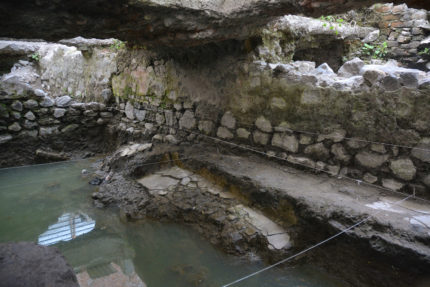Archaeologists from Mexico’s National Institute of Anthropology and History (INAH) have unearthed the remains of a pre-Hispanic sweat lodge dating to the 14th century. It was made out of adobe and tezontle, a local volcanic rock, and then coated with stucco. A large section of walls, the central tub and a bench along the side are extant. The sweat house would have been about 16 feet long and 10 feet wide when intact.
Known in Nahuatl as temazcals, these mud-brick or stone structures were domed sweat lodges with warm water pools or steam baths, a lower heat version of the Roman sudatorium. Unlike the Roman bathing practice, temazcals were used for ritual and medicinal purposes. They were also used by women in childbirth.
The temazcal was discovered in the La Merced neighborhood. The remains of the sweat lodge are the first concrete archaeological evidence that what is now La Merced was originally Temazcaltitlan, one of the oldest neighborhoods in Tenochtitlan. It was known from written sources from the colonial era including the Nahuatl-language Crónica Mexicayotl and Aubin Codex and the Sigüenza Map, a cartographic history of the migration of the Mexica from Aztlán to Tenochtitlan.
The account of the settlement of Tenochtitlan in Crónica Mexicayotl describes the temazcal as pretty much the first thing built by the handful of nobles who founded the city before the wider population of Mexica followed. They had been violently expelled from Tizapán and fled to the swamps around the central lagoon of what would become Tenochtitlan. During the dangerous escape, Quetzalmoyahuatzin, daughter of one of the Mexica nobles, gave birth. The founders erected a sweat house there where they bathed her and themselves. The spot was named Temazcaltitlan after the temazcal.
The head of the INAH team that found the temazcal said the discovery is the first concrete evidence of Temazcaltitlan’s vocation as a center of bathing and purification.
Víctor Esperón Calleja said the neighborhood belonged to the district of Teopan (also known as Zoquipan), which was the first territory built on Lake Texcoco and occupied by the Mexicas. It is believed that the female deities of earth, fertility, water and the pre-Hispanic beverage pulque were also worshipped in Temazcaltitlan.
On the west side of the site, the INAH team unearthed the remains of an early colonial house with several rooms built over the temazcal. It was constructed using both pre-Hispanic and European techniques, so archaeologists believe it belonged to a high-status indigenous family in the immediate wake of the Spanish Conquest, between 1521 and 1620. A hundred years later under the Spanish Viceroyalty (1720-1820), a tannery was built on the site.
This video in Spanish (the auto-translate captions are, as usual, bad, but at least vaguely understandable) has great shots of the site.

It was made out of adobe and tezontle, a local volcanic rock, and then coated with stucco.
Still…it’s concrete!
its the biggest city in mexico. u cant flush toliet paper and is a very dry place. also u need to have either passos or american money. also there is alot of nice mexican people there. there is also markets to buy things
El spa con las tinas en el predio
[..]Yo soy excited!